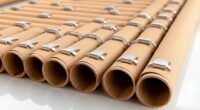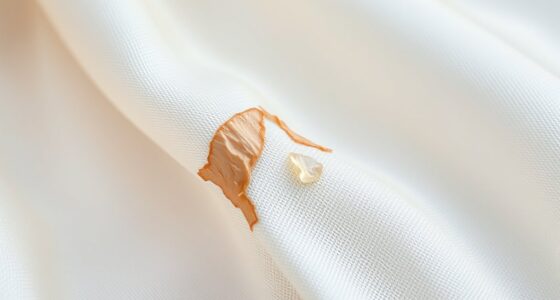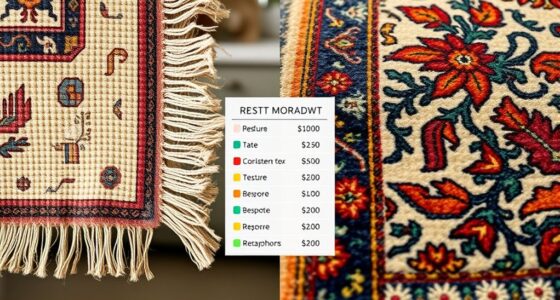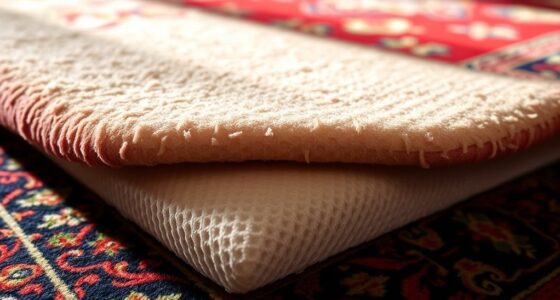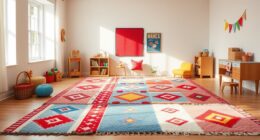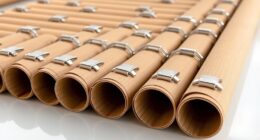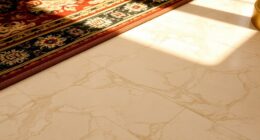Using a properly selected rug pad can substantially extend your carpet’s lifespan, often by up to 30%. A good pad absorbs friction, prevents shifting, and protects fibers from unnecessary wear, especially on high-traffic areas. Choosing the right material and thickness is key to maximizing these benefits. To discover how proper rug pad choices and maintenance can keep your carpet looking new longer, explore more tips and insights below.
Key Takeaways
- Proper rug pad selection reduces friction and uneven wear, significantly extending carpet lifespan.
- Using high-quality, appropriate materials prevents fiber fraying and matting, boosting durability.
- Correct installation minimizes bunching and shifting, decreasing damage and preserving carpet integrity.
- Regular maintenance like vacuuming and rotating ensures even wear and prevents premature deterioration.
- Proper pad and rug pairing maintains structural support, reducing indentations and increasing overall longevity.
The Impact of Rug Pads on Carpet Durability

Rug pads play an essential role in extending the lifespan of your carpets by providing a protective barrier that reduces wear and tear. They absorb the friction caused by foot traffic, preventing fibers from fraying and matting over time. Without a rug pad, your carpet endures more pressure, leading to quicker deterioration, especially in high-traffic areas. Rug pads also distribute weight evenly, preventing permanent indentations and uneven wear patterns. Additionally, they help keep your rug in place, reducing the risk of slipping that can cause tears or damage. By cushioning the impact of daily foot traffic and furniture, rug pads preserve your carpet’s appearance and structural integrity. Using a HEPA filtration air purifier in your home can further help maintain a clean environment, reducing dust and allergens that may accelerate carpet deterioration. Investing in a quality rug pad ultimately saves you money by maintaining your carpet’s durability longer.
Key Features to Look for in a Rug Pad
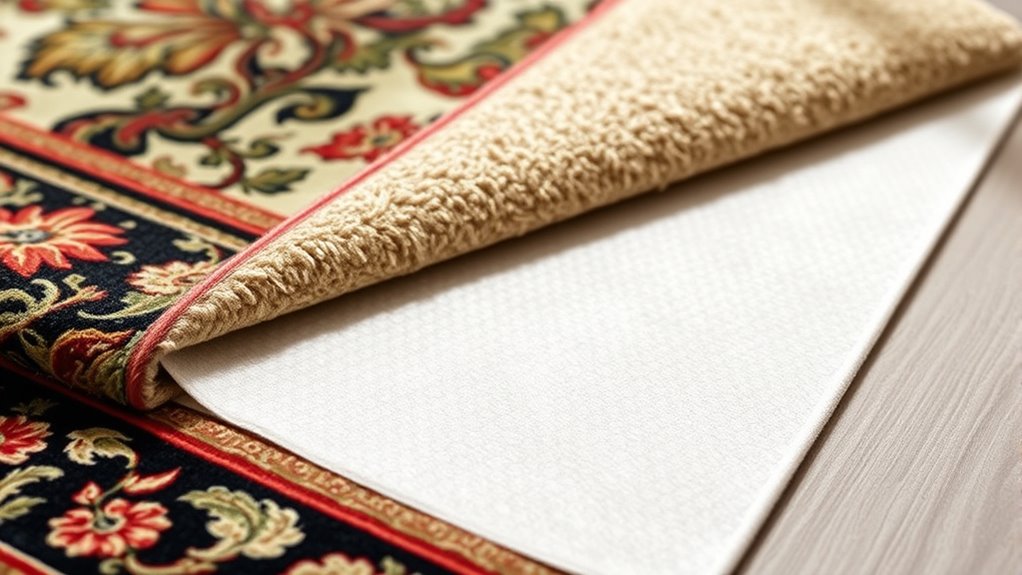
Choosing the right rug pad involves prioritizing specific features that enhance both durability and safety. Look for a pad made from high-quality materials like natural rubber, felt, or a blend, ensuring it’s sturdy enough to support your rug daily. A good rug pad should be non-slip, so it stays securely in place, preventing bunching or shifting. It also needs to be breathable, allowing air circulation that helps prevent mold and odors beneath your rug. Monitoring AI vulnerabilities and the development of safety measures are increasingly important in product design to ensure reliability. Thickness matters too; a pad that’s too thin won’t protect your carpet adequately, while one that’s too thick may cause uneven wear. Additionally, opt for eco-friendly options free from harmful chemicals, ensuring your space remains safe for everyone. Prioritizing these features helps extend your rug’s lifespan and maintains a safe, comfortable environment.
How a Rug Pad Prevents Slipping and Movement
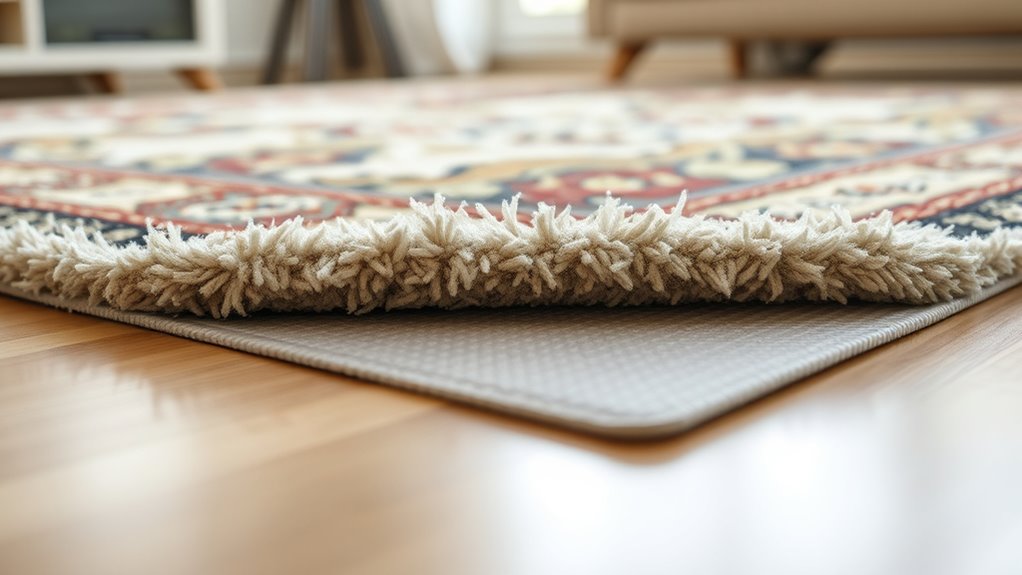
A high-quality rug pad actively prevents slipping and shifting by creating friction between your rug and the floor. This friction keeps the rug securely in place, reducing the risk of accidents or damage. The following factors enhance its grip:
- Material Composition — Natural rubber or felt considerably increases grip.
- Surface Texture — Textured surfaces add extra friction for stability.
- Floor Compatibility — Designed to work on hardwood, tile, or carpeted floors.
- Thickness and Density — Thicker, denser pads provide more grip and cushioning.
Together, these elements work synergistically to keep your rug steady, even in high-traffic areas. Properly chosen rug pads not only prevent movement but also help maintain your rug’s shape and position over time. Additionally, using a professional-grade rug pad can further improve durability and grip performance.
Common Mistakes When Choosing Rug Padding
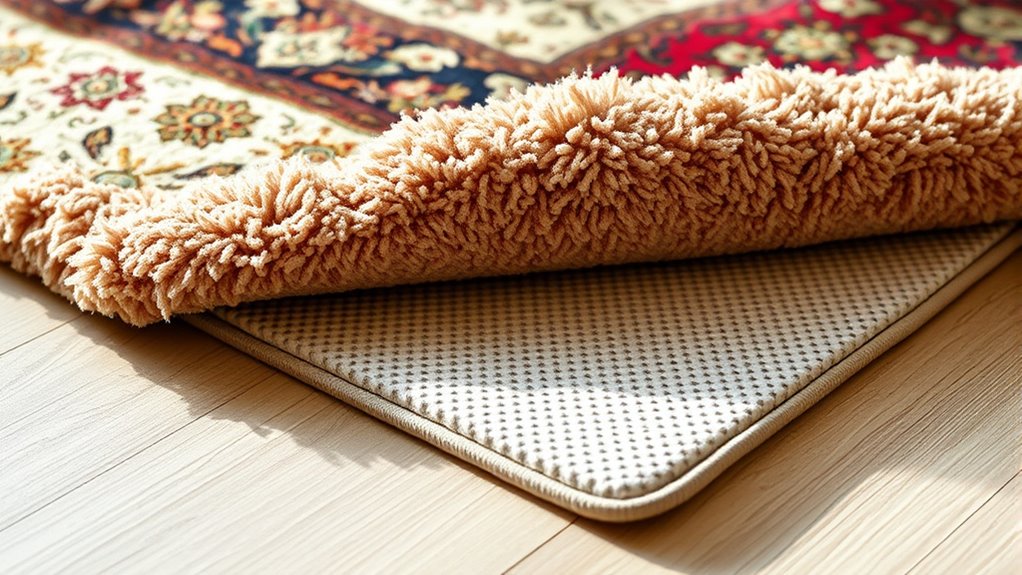
One common mistake is selecting a rug pad that isn’t suited for your specific flooring type, which can lead to slipping, damage, or reduced durability. For example, using a rubber pad on hardwood may cause discoloration or staining over time. Conversely, a thin felt pad on tile might not provide enough cushioning or grip. You might also overlook the thickness of the pad, choosing one that’s too thick or too thin for your rug and floor combination, affecting stability and comfort. Another mistake is ignoring the rug’s size and weight, which impacts the pad’s suitability. Failing to contemplate these factors can shorten your rug’s lifespan and compromise safety. Additionally, choosing a pad without considering the appropriate material for your flooring can result in adverse effects such as slipping or damage. Always match your rug pad to your flooring type, rug size, and weight for optimal performance.
Comparing Different Types of Rug Pads
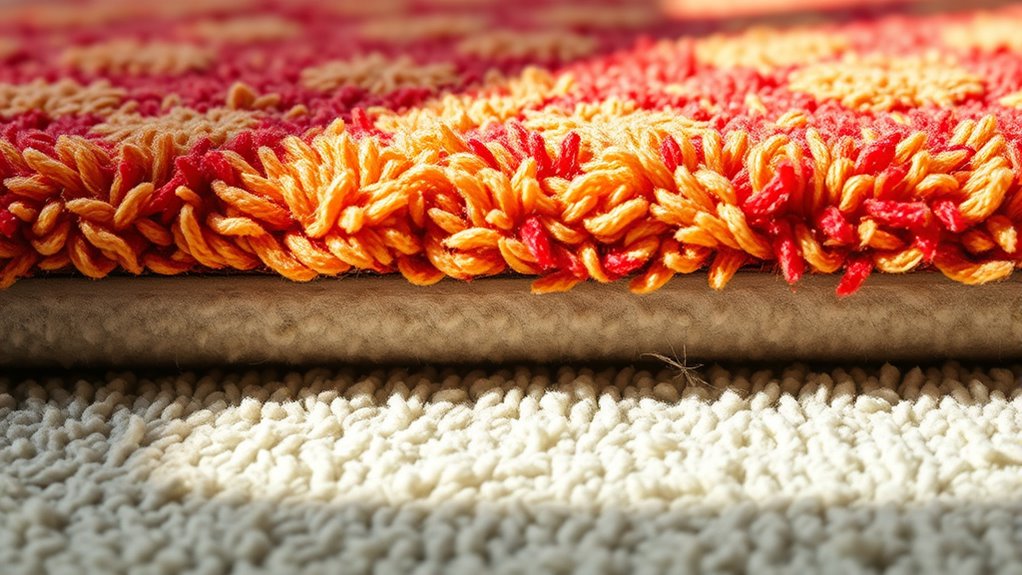
When comparing rug pads, you’ll want to contemplate material durability and how well each type supports your rug and floor. Some materials last longer and provide firmer cushioning, while others offer softer support but may wear out faster. Understanding these differences helps you choose the right pad for your needs. Additionally, selecting a proper rug pad can help prolong the life of your carpet by reducing wear and tear over time.
Material Durability Comparison
Since different rug pad materials vary substantially in their ability to withstand wear and tear, understanding their durability is essential for making an informed choice. Here’s a quick comparison:
- Rubber pads are highly durable, resisting compression and damage over time.
- Felt pads tend to wear down faster, especially under heavy foot traffic.
- PVC pads offer moderate durability but can degrade with prolonged exposure to heat or sunlight.
- Natural fiber pads, like jute, are less durable and may fray or compress quickly.
- The material composition of a rug pad directly influences its longevity and performance.
Your choice depends on your needs—rubber offers longevity, while felt provides a softer feel initially but may need replacing sooner. Knowing each material’s lifespan helps you select the best option for extending your carpet’s life.
Cushioning and Support Levels
Different rug pad materials not only vary in durability but also provide varying levels of cushioning and support. If you want your rug to feel plush and comfortable underfoot, choose a thicker, softer pad like rubber or felt. These materials absorb impact and add a layer of comfort, making your space cozier. Conversely, if you need more support to prevent slipping or shifting, opt for thinner, denser pads such as rubber or latex. These provide firm backing that stabilizes your rug and protects your flooring. Keep in mind that excessive cushioning can sometimes cause bunching or uneven wear, while too little support may lead to faster deterioration of your carpet. Matching the rug pad’s cushioning level to your needs enhances comfort, stability, and longevity. Additionally, choosing the appropriate pad can prevent premature wear and extend the overall lifespan of your carpet.
Cost-Benefit Analysis of Using Quality Rug Pads
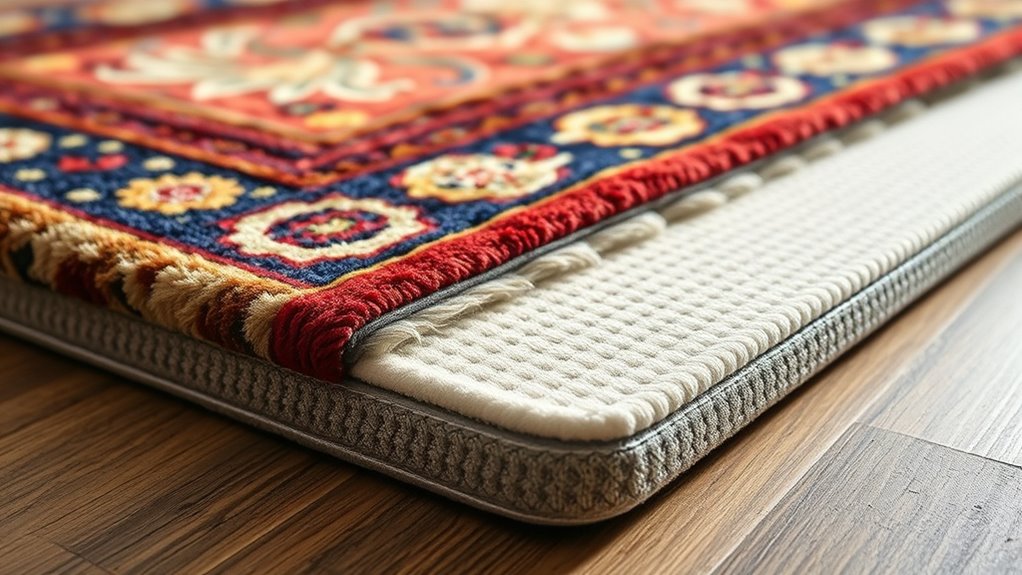
Investing in a high-quality rug pad can seem like an added expense upfront, but it often pays off in the long run. The benefits include saving money by extending your carpet’s lifespan and reducing replacement costs. Consider these key points:
- Durability: Quality pads prevent premature wear, saving you from frequent replacements.
- Protection: They shield your rug from damage caused by furniture and foot traffic.
- Maintenance: Proper pads can lower cleaning and repair expenses over time.
- Comfort: Enhanced cushioning reduces strain on your floors and furniture, adding value to your space.
- Additionally, using a rug pad that promotes proper space and organization can help maintain a tidy and functional area, preventing clutter buildup that can lead to unnecessary wear and tear.
Installation Tips for Maximum Carpet Protection
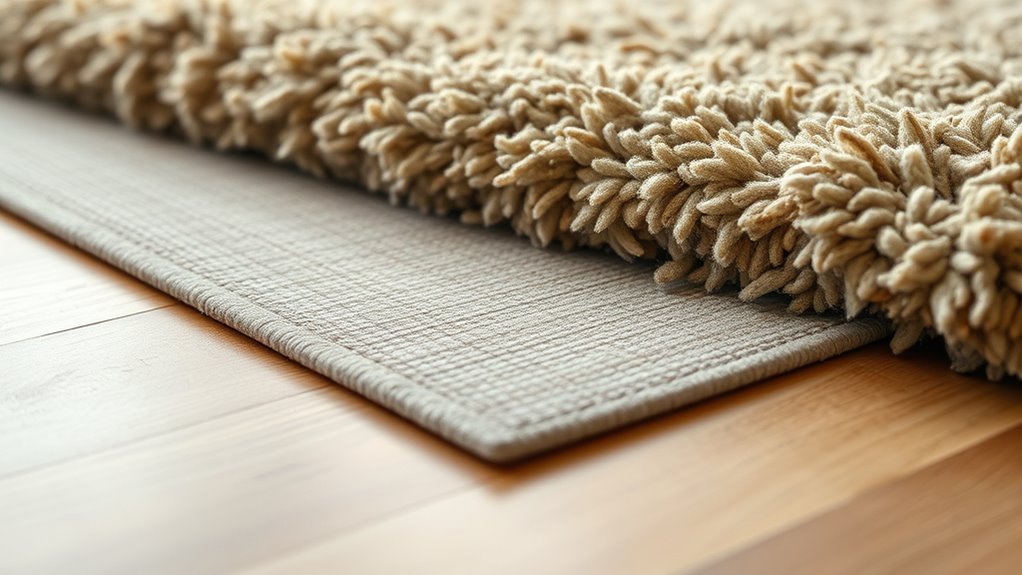
To guarantee you get the most protection from your rug pad, proper installation is key. First, ensure your floor is clean and dry before placing the pad. Measure your rug and cut the pad to fit snugly without overlapping edges, preventing bunching or shifting. Lay the pad flat on the floor, smoothing out any wrinkles or creases. If your rug is in a high-traffic area, consider using double-sided tape or non-slip backing to keep it securely in place. Avoid stretching or pulling the rug during installation, as this can cause uneven wear. Finally, check that the rug remains flat and properly aligned over the pad, ensuring even weight distribution. Proper installation maximizes protection, prolonging your carpet’s lifespan considerably.
Maintaining Your Rug and Pad for Longevity
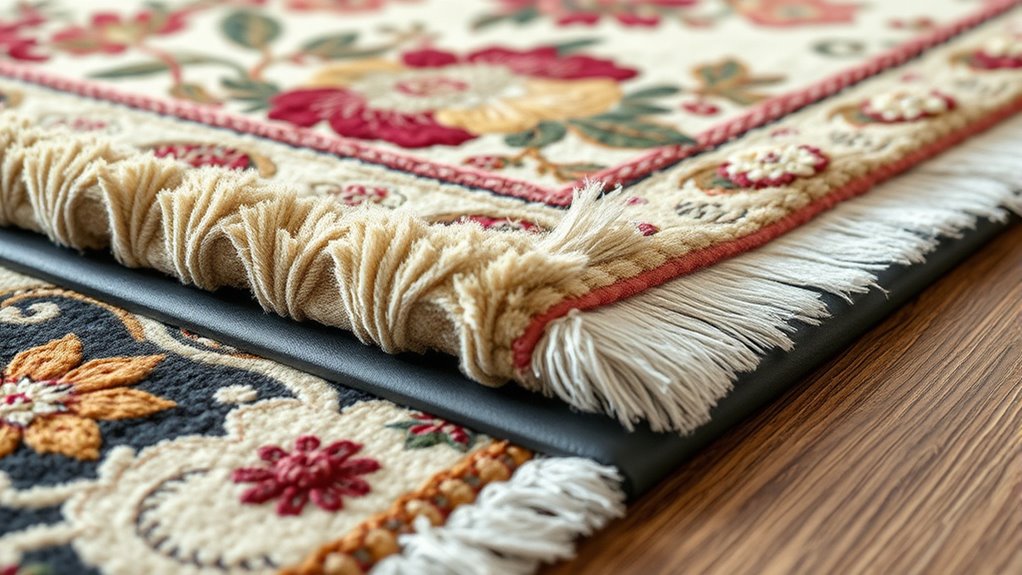
To keep your rug and pad in great shape, regular cleaning is essential. Make sure you place them properly and avoid unnecessary friction or movement. These simple steps will help extend their lifespan and keep your space looking fresh. Maintaining a clean environment can also prevent the buildup of dirt and grime, further protecting your investment.
Regular Cleaning Practices
Have you wondered how regular cleaning can extend the life of your rug and its pad? Consistent upkeep prevents dirt buildup and preserves their integrity. Here are four key practices:
- Vacuum weekly to remove surface debris and prevent particles from settling.
- Rotate your rug every 3-6 months to ensure even wear.
- Spot clean spills immediately to prevent staining and fiber damage.
- Schedule professional deep cleaning at least once a year to eliminate embedded dirt and allergens.
- Using skincare patches on your rug and pad can help prevent dirt accumulation and maintain cleanliness over time.
Proper Placement and Use
Proper placement and correct use are key to maximizing the lifespan of both your rug and its pad. Confirm your rug lies flat without bunching or wrinkles, which can cause uneven wear. Position the pad underneath evenly, avoiding overlaps that create bumps or gaps. Use a non-slip rug pad to prevent slipping and shifting, which can damage edges. Regularly check the pad’s placement, especially in high-traffic areas.
| Aspect | Tip |
|---|---|
| Rug positioning | Lay flat, smooth out wrinkles |
| Pad alignment | Center beneath rug, avoid overlaps |
| Maintenance | Adjust as needed, keep clean and dry |
Expert Recommendations for Rug Pad Selection
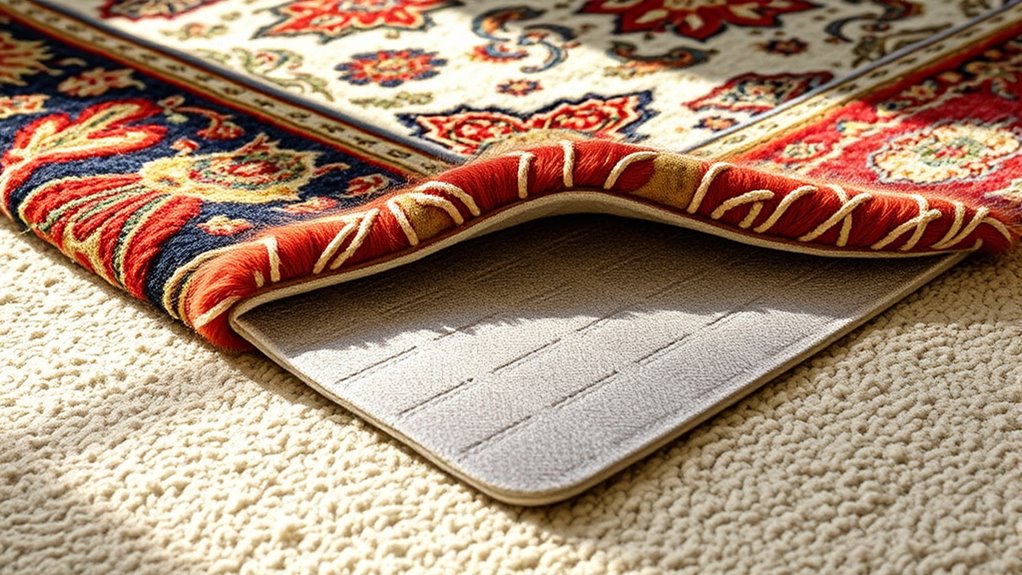
When selecting a rug pad, expert recommendations emphasize the importance of matching the pad’s material and thickness to your rug and flooring type. Choosing the right pad can prevent slipping, protect your floor, and extend your rug’s life. Consider these guidelines:
- For hardwood floors, opt for non-slip, thin pads to prevent damage.
- For plush or thick rugs, choose thicker, cushioning pads for comfort and support.
- Use natural materials like felt or wool for breathability and durability.
- Avoid rubber pads on certain flooring types to prevent staining or discoloration.
Frequently Asked Questions
How Do Rug Pads Affect Indoor Air Quality Over Time?
Rug pads can influence your indoor air quality over time by trapping dust, allergens, and pet dander beneath your rugs. If you choose a non-ventilated or poorly maintained pad, these particles can accumulate and potentially be released into the air, causing allergies or respiratory issues. Regular cleaning and selecting breathable, non-toxic rug pads help improve your indoor air quality, ensuring a healthier living environment for you and your family.
Are There Eco-Friendly Options for High-Quality Rug Pads?
You’re wondering if eco-friendly options for high-quality rug pads exist. Yes, they do! You can choose pads made from natural materials like felt, rubber, or cork, which are biodegradable and free from harmful chemicals. These options provide excellent cushioning and durability while being environmentally responsible. By selecting eco-friendly rug pads, you’re not only protecting your carpet but also reducing your ecological footprint, making your home healthier and greener.
Can Rug Pads Be Used on Heated Flooring Systems?
Using a rug pad on heated flooring systems can seem intimidating, but it’s totally doable and can protect your floors and carpets. You should choose a breathable, non-slip rug pad designed for radiant heat, ensuring it won’t trap heat or cause damage. With the right pad, you can enjoy cozy warmth and extend your carpet’s life—potentially more than you ever imagined—while keeping your floors safe and stylish.
What Are Signs of Wear Indicating the Need for a New Rug Pad?
You’ll know it’s time for a new rug pad when you notice it’s flattening or losing its grip, causing your rug to slip. If you see uneven wear, fraying edges, or permanent indentations, those are signs it’s no longer providing proper support. Also, if the pad feels compressed or isn’t cushioning like it used to, replacing it will help protect your carpet and maintain a fresh, secure look.
Do Rug Pads Impact the Ease of Carpet Cleaning and Maintenance?
Rug pads definitely impact how easy it is to clean and maintain your carpet. A good pad keeps the rug stable, preventing bunching and trapping debris underneath, making vacuuming more effective. It also reduces wear and tear, so you won’t need to replace your rug as often. Choosing the right pad can simplify your cleaning routine, ensuring your carpet stays fresh and in great condition longer.
Conclusion
Choosing the right rug pad not only protects your carpet but can surprisingly extend its life by up to 30%. When you pick the proper pad, you’ll notice fewer slips, less wear, and a more comfortable feel underfoot. It’s funny how a small investment in quality can make such a big difference over time. So, take the time to select and maintain your rug pad—your carpet will thank you for it in the years to come.

